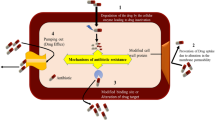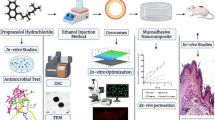Abstract
This study aims to investigate radiolabeled Cefpodoxime Proxetil loaded chitosan (CP–CS) nanoparticles as nuclear imaging infection agent to Gram-positive Staphylococcus aureus (S. aureus) and Gram-negative Escherichia coli (E. coli). The encapsulation efficiency of Cefpodoxime Proxetil was found 82 ± 2%. CP and CP–CS nanoparticles were radiolabeled with Tc-99 m. The radiochemical purity of 99mTc–CP and 99mTc–CP–CS nanoparticles were determined by RTLC as 89 ± 3% and 94 ± 2% respectively. In vitro bindings of 99mTc–CP–CS nanoparticles to S. aureus and E. coli were found higher than 99mTc–CP bindings.







Similar content being viewed by others
References
Tran PA, Zhang L, Webster TJ (2009) Carbon nanofibers and carbon nanotubes in regenerative medicine. Adv Drug Deliv Rev 61:1097–1114. https://doi.org/10.1016/j.addr.2009.07.010
Uhrich KE, Cannizzaro SM, Langer RS, Shakesheff KM (1999) Polymeric systems for controlled drug release. Chem Rev 99:3181–3198. https://doi.org/10.1021/cr940351u
Huh AJ, Kwon YJ (2011) “Nanoantibiotics”: a new paradigm for treating infectious diseases using nanomaterials in the antibiotics resistant era. J Control Release 156:128–145. https://doi.org/10.1016/j.jconrel.2011.07.002
Zhang H, Jung J, Zhao Y (2016) Preparation, characterization and evaluation of antibacterial activity of catechins and catechins–Zn complex loaded β-chitosan nanoparticles of different particle sizes. Carbohydr Polym 137:82–91. https://doi.org/10.1016/j.carbpol.2015.10.036
Borin MT (1991) A review of the pharmacokinetics of cefpodoxime proxetil. Drugs 42:13–21. https://doi.org/10.2165/00003495-199100423-00005
Löbenberg R, Amidon GL (2000) Modern bioavailability, bioequivalence and biopharmaceutics classification system. New scientific approaches to international regulatory standards. Eur J Pharm Biopharm 50:3–12. https://doi.org/10.1016/S0939-6411(00)00091-6
Sugimoto M, Okagaki T, Narisawa S et al (1998) Improvement of dissolution characteristics and bioavailability of poorly water-soluble drugs by novel cogrinding method using water-soluble polymer. Int J Pharm 160:11–19. https://doi.org/10.1016/S0378-5173(97)00293-7
Patil SH, Talele GS (2014) Natural gum as mucoadhesive controlled release carriers: evaluation of Cefpodoxime Proxetil by D-Optimal design technique. Drug Deliv 21:118–129. https://doi.org/10.3109/10717544.2013.834416
Siraj SN, Shaharukh Ismail M, Khan GJ et al (2020) Design expert software assisted development and evaluation of cefpodoxime proxetil matrix tablet. Int J Pharm Sci Res 11:2431. https://doi.org/10.13040/IJPSR.0975-8232.11(5).2431-43
Kukati L, Chıttımalli K, Shaik NB, Thoudoju S (2018) Formulation and evaluation of sintered floating tablets of cefpodoxime proxetil. Pharm Sci 15:278–290. https://doi.org/10.4274/tjps.59454
Kwak SY, Lew TTS, Sweeney CJ et al (2019) Chloroplast-selective gene delivery and expression in planta using chitosan-complexed single-walled carbon nanotube carriers. Nat Nanotechnol 14:447–455. https://doi.org/10.1038/s41565-019-0375-4
Rabea EI, Badawy ME-T, Stevens CV et al (2003) Chitosan as antimicrobial agent: applications and mode of action. Biomacromol 4:1457–1465. https://doi.org/10.1021/bm034130m
Tin S, Sakharkar KR, Lim CS, Sakharkar MK (2009) Activity of Chitosans in combination with antibiotics in Pseudomonas aeruginosa. Int J Biol Sci 5:153–160. https://doi.org/10.7150/ijbs.5.153
Qi L, Xu Z, Jiang X et al (2004) Preparation and antibacterial activity of chitosan nanoparticles. Carbohydr Res 339:2693–2700. https://doi.org/10.1016/j.carres.2004.09.007
Cuero RG, Osuji G, Washington A (1991) N-carboxymethylchitosan inhibition of aflatoxin production: role of zinc. Biotechnol Lett 13:441–444. https://doi.org/10.1007/BF01030998
Balland Olivier, Pinto-Alphandary H (1994) The uptake of ampicillin-loaded nanoparticles by murine macrophages infected with Salmonella typhimuriume. J Antimicrob Chemother 33:509–522
Yurt F, Ersöz OA, Harputlu E, Ocakoglu K (2018) Preparation and evaluation of effect on Escherichia coli and Staphylococcus aureus of radiolabeled ampicillin-loaded graphene oxide nanoflakes. Chem Biol Drug Des 91:1094–1100. https://doi.org/10.1111/cbdd.13171
Ocakoglu K, Yildirim Y, Yurt Lambrecht F et al (2008) Biological investigation of 131 I-labeled new water soluble Ru(II) polypyridyl complex. Appl Radiat Isot 66:115–121. https://doi.org/10.1016/j.apradiso.2007.07.033
Jamil B, Habib H, Abbasi SA et al (2016) Development of cefotaxime ımpregnated chitosan as nano-antibiotics: de novo strategy to combat biofilm forming multi-drug resistant pathogens. Front Microbiol 7:330. https://doi.org/10.3389/fmicb.2016.00330
Jamil B, Habib H, Abbasi S et al (2016) Cefazolin loaded chitosan nanoparticles to cure multi drug resistant Gram-negative pathogens. Carbohydr Polym 136:682–691. https://doi.org/10.1016/j.carbpol.2015.09.078
Ribeiro TG, Chávez-Fumagall MA, Valadares DG et al (2014) Novel targeting using nanoparticles: an approach to the development of an effective anti-leishmanial drug-delivery system. Int J Nanomed 9:877–890. https://doi.org/10.2147/IJN.S55678
Khan F, Katara R, Ramteke S (2010) Enhancement of bioavailability of cefpodoxime proxetil using different polymeric microparticles. AAPS PharmSciTech 11:1368–1375. https://doi.org/10.1208/s12249-010-9505-x
Wiedemann B, Luhmer E, Zühlsdorf MT (1991) Microbiological evaluation of cefpodoxime proxetil. Drugs 42:6–12. https://doi.org/10.2165/00003495-199100423-00004
Clogston JD, Patri AK (2011) Zeta potential measurement. In: McNeil SE (ed) Characterization of nanoparticles ıntended for drug delivery. Humana Press, Totowa, pp 63–70
Gazori T, Khoshayand MR, Azizi E et al (2009) Evaluation of Alginate/Chitosan nanoparticles as antisense delivery vector: formulation, optimization and in vitro characterization. Carbohydr Polym 77:599–606. https://doi.org/10.1016/j.carbpol.2009.02.019
Davis SS (1997) Biomédical applications of nanotechnology—implications for drug targeting and gene therapy. Trends Biotechnol 15:217–224. https://doi.org/10.1016/S0167-7799(97)01036-6
Mohammadpour Dounighi N, Eskandari R, Avadi MR et al (2012) Preparation and in vitro characterization of chitosan nanoparticles containing Mesobuthus eupeus scorpion venom as an antigen delivery system. J Venom Anim Toxins Incl Trop Dis 18:44–52. https://doi.org/10.1590/s1678-91992012000100006
Elçin E (2013) Panomycocin-incorporated chitosan-tpp nanoparticles: preparation, characterization and in vitro determination of antifungal activity against human dermatophytes. Master Thesis, Middle East Technical University, Institute of Science, Ankara. https://open.metu.edu.tr/handle/11511/22920
Azevedo JR, Sizilio RH, Brito MB et al (2011) Physical and chemical characterization insulin-loaded chitosan-TPP nanoparticles. J Therm Anal Calorim 106:685–689. https://doi.org/10.1007/s10973-011-1429-5
Knaul JZ, Hudson SM, Creber KAM (1999) Improved mechanical properties of chitosan fibers. J Appl Polym Sci 72:17211732
Mujtaba A, Ali M, Kohli K (2014) Formulation of extended release cefpodoxime proxetil chitosan–alginate beads using quality by design approach. Int J Biol Macromol 69:420–429. https://doi.org/10.1016/j.ijbiomac.2014.05.066
Sobhani Z, Mohammadi Samani S, Montaseri H, Khezri E (2017) Nanoparticles of chitosan loaded ciprofloxacin: fabrication and antimicrobial activity. Adv Pharm Bull 7:427–432. https://doi.org/10.15171/apb.2017.051
Shahzadi SK, Qadir MA, Shabnam S, Javed M (2015) 99mTc-amoxicillin: a novel radiopharmaceutical for infection imaging. Arab J Chem. https://doi.org/10.1016/J.ARABJC.2015.04.003
Ribeiro TG, Franca JR, Fuscaldi LL et al (2014) An optimized nanoparticle delivery system based on chitosan and chondroitin sulfate moleculeseduces the toxicity of amphotericin B and is effective in treating tegumentary leishmaniasis. Int J Nanomedicine. https://doi.org/10.2147/IJN.S68966
Author information
Authors and Affiliations
Corresponding author
Ethics declarations
Conflict of interest
The authors declare that they have no conflict of interest.
Additional information
Publisher's Note
Springer Nature remains neutral with regard to jurisdictional claims in published maps and institutional affiliations.
Rights and permissions
About this article
Cite this article
Özel, D., Yurt, F. Investigation of radiolabelled chitosan nanoparticles bearing Cefpodoxime Proxetil, and in vitro antibacterial effect on Gram-positive Staphylococcus aureus and Gram-negative Escherichia coli. J Radioanal Nucl Chem 326, 1551–1558 (2020). https://doi.org/10.1007/s10967-020-07430-z
Received:
Accepted:
Published:
Issue Date:
DOI: https://doi.org/10.1007/s10967-020-07430-z




